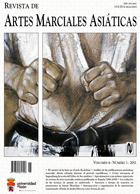Como incorpora o baguazhang a teoria do Livro dos câmbios
DOI:
https://doi.org/10.18002/rama.v6i1.85Palavras-chave:
Bagua, artes marciais chinesas, taoísmo, YijingResumo
Neste artigo, o autor examina como um artista marcial pode aplicar os aspectos teóricos do Yijing no seu treino e trata de determinar como é que os praticantes de baguazhang escolheram o texto particular como núcleo do seu sistema. Mediante este exame, podemos estudar algumas das formas mediante as que o baguazhang se vinculava à cultura em que se desenvolveu.Downloads
Métricas alternativas
Referências
Bracy, J. & Liu, X. (1998). Ba gua: Hidden knowledge in the Taoist internal martial art. Berkeley, CA: North Atlantic Books.
Farquhar, J. (1996). Knowing practice: The clinical encounter of Chinese medicine. Boulder, CO: Westview Press.
Gallin, B. (1978). “Comments on Contemporary Sociocultural Studies of Medicine in Chinese Societies”. En Arthur Kleinman et al. eds., Culture and Healing in Asian Societies: Anthropological, Psychiatric, and Public Health Studies (173–181). Cambridge: Schenkman.
Johnson, J. (1984). The master’s manual of Pa Kua Chang. Pacific Grove, CA: Ching Lung Martial Arts Association.
Liang, S., Yang, J., & Wu, W. (1994). Emei baguazhang: Theory and applications. Boston: YMAA Publication Center.
Lynn, R. (1994). The classic of change: A new translation of the I Ching as interpreted by Wang Bi. New York: Columbia University Press.
Obeyesekere, G. (1978). “Illness, culture, and meaning: Some comments on the nature of traditional medicine”. En Arthur Kleinman et al. eds., Culture and Healing in Asian Societies: Anthropological, Psychiatric, and Public Health Studies (253–263). Cambridge: Schenkman.
Ma, M. (2009). “Reconstructing China’s indigenous physical culture”. Journal of Chinese Martial Studies, 1, 8–31.
Park, B. and Miller, D. (1993). The fundamentals of Pa Kua Chang. Pacific Grove, CA: High View Publications.
Peterson, W. (1982). “Making connections: ‘Commentary on the attached verbalizations’ of the Book of Changes.” Harvard Journal of Asiatic Studies, 42(1), 67–116.
Porkert, M. (1974). The theoretical foundations of Chinese medicine: Systems of correspondence. Cambridge: MIT Press.
Shahar, M. (2008). The Shaolin Monastery: History, religion, and the Chinese martial arts. Honolulu: University of Hawai’i Press.
Smith, K. (1993). “The difficulty of the Yijing.” Chinese Literature: Essays, Articles, Reviews, 15, 1–15.
Smith, R. (2008). Fathoming the cosmos and ordering the world. Charlottesville, VA: University of Virginia Press.
Vargas, F. (1983). Pa-kua: The gentleman’s boxing. Los Angeles: Vision Press Films.
Unschuld, P. (1985). Medicine in China, a history of ideas. Berkeley, CA: University of California Press.
Wilhelm, H. (1977). Heaven, earth, and man in the Book of Changes: Seven eranos lectures. Seattle: University of Washington Press.
Downloads
Publicado
Como Citar
Edição
Secção
Licença
Direitos de Autor (c) 2012 Travis Joern

Este trabalho encontra-se publicado com a Licença Internacional Creative Commons Atribuição-NãoComercial-CompartilhaIgual 4.0.
Os autores que publicam nesta Revista estão de acordo com os seguintes termos:
- Os autores cedem, de forma exclusiva, os direitos de exploração (reprodução, distribuição, comunicação pública, transformação) à Universidade de Léon, podendo estabelecer, em separado, acordos adicionais para a distribuição não exclusiva da versão do artigo publicado na Revista (por exemplo: alojar no repertório institucional ou publicá-lo num livro), com o reconhecimento da publicação inicial nesta Revista.
- O trabalho encontra-se na Creative Commons Attribution-Non Commercial-Share Alike 4.0 International License. Pode-se consultar aqui o resumo e o texto legal da licença.
- Permite-se, e sugere-se, que os autores difundam electronicamente as versões pré-impressão (versão antes de ser avaliada) e pós-impressão (versão avaliada e aceite para publicação das suas obras antes da sua publicação), favorecendo a sua circulação e difusão, e com ela o possível aumento da sua citação e alcance pela comunidade académica.











